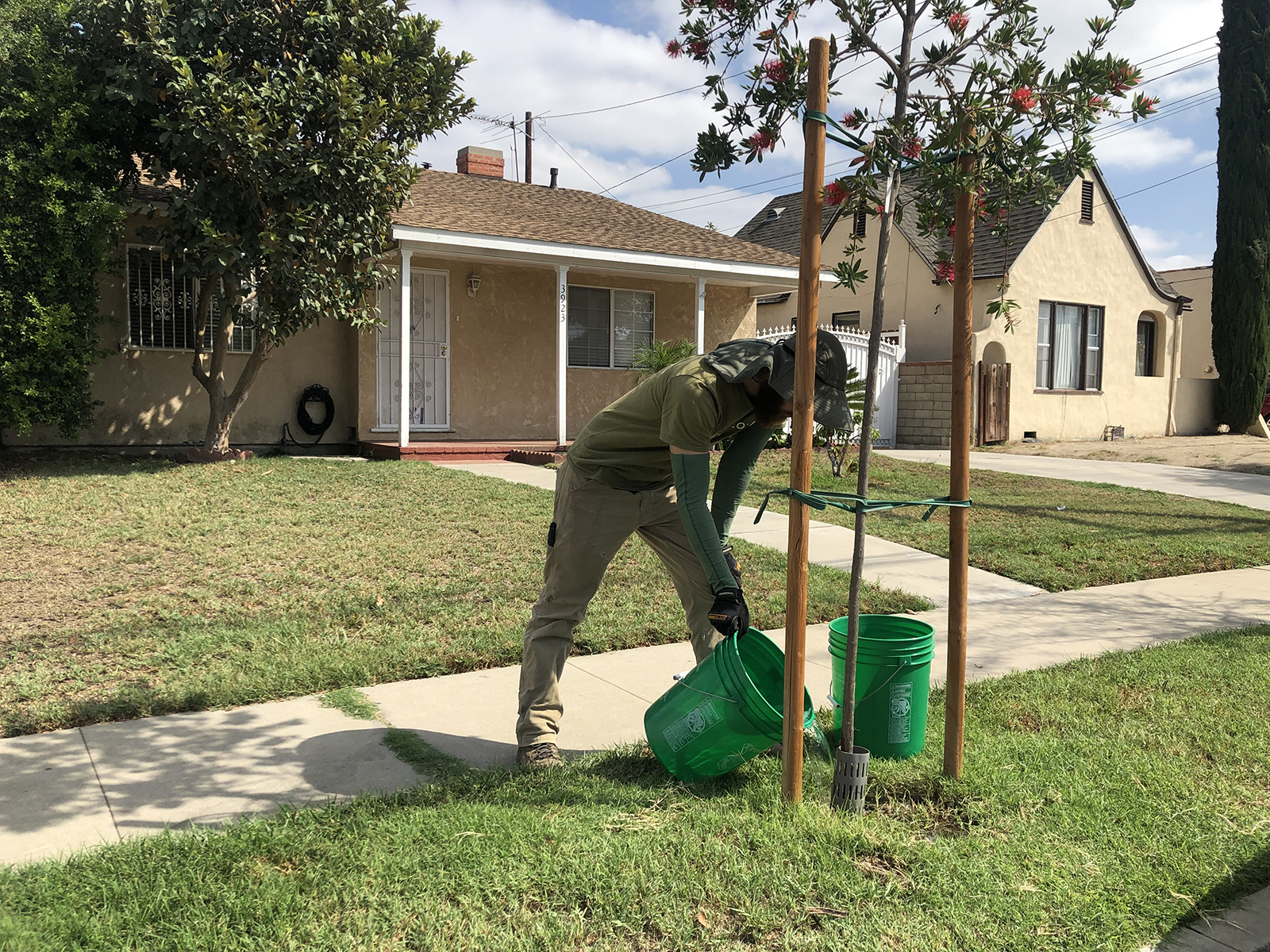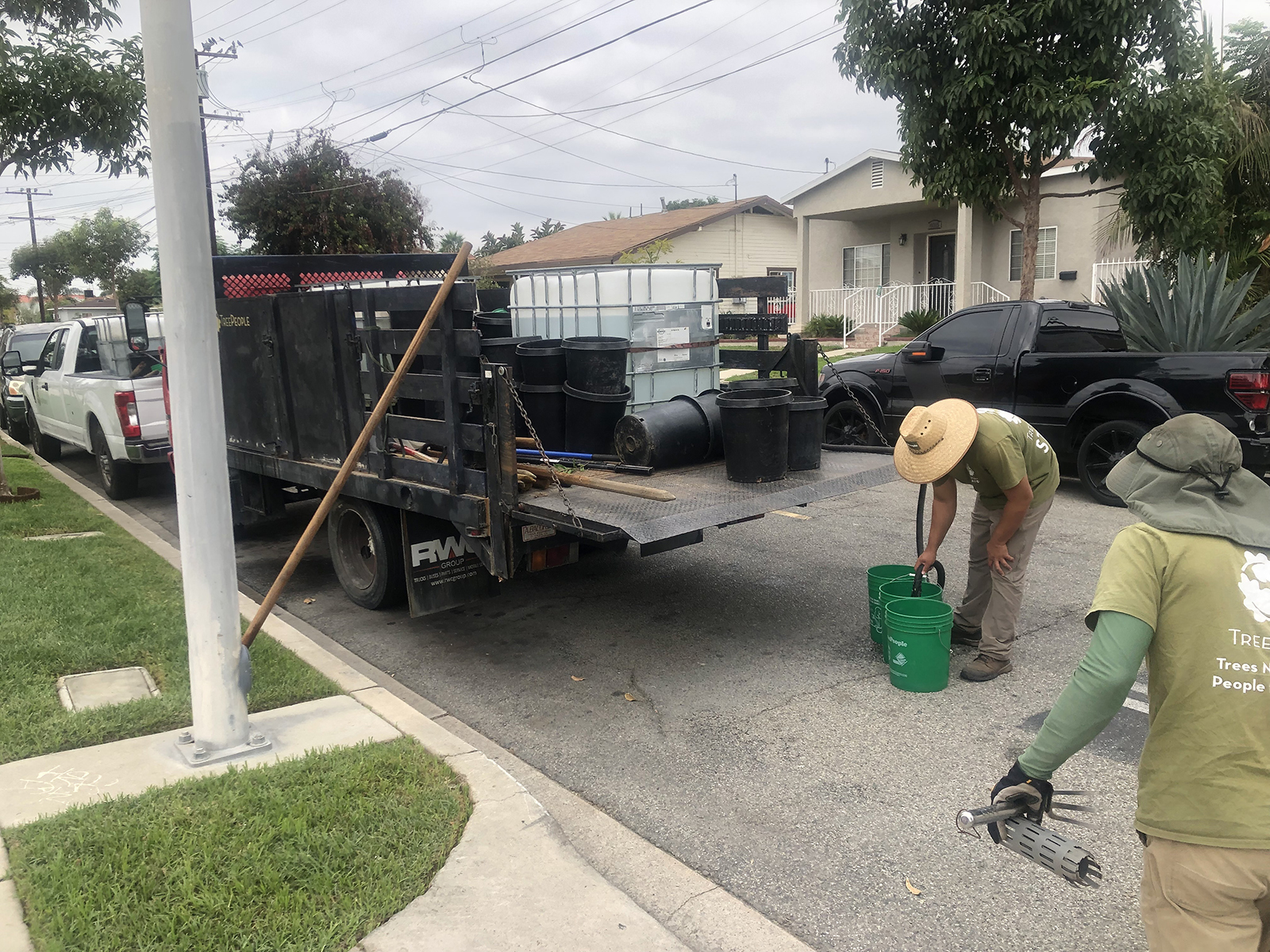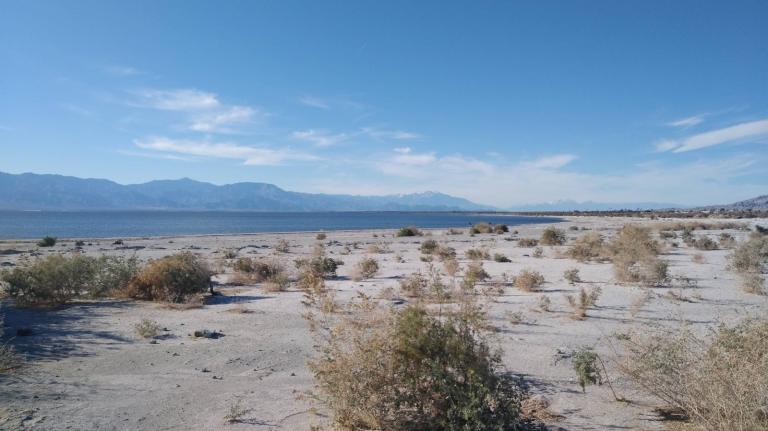This story is part of the Grist series Parched, an in-depth look at how climate change-fueled drought is reshaping communities, economies, and ecosystems.
On an overcast Thursday morning in September, a team of five people slowly makes its way down Broadway Avenue, a residential street in the city of Huntington Park, California. Every couple hundred feet they park their pickup trucks, loaded with 275 gallon water tanks, hop out, and fan out along the street, dousing the roots of young trees lining the strip between the sidewalk and the road.
The watering team, from the nonprofit TreePeople, is responsible for thousands of newly planted trees in seven low-income neighborhoods in Los Angeles County, including Watts, South Gate, and Lynwood; each tree comes with a guarantee that the nonprofit will provide water and other maintenance for at least 3 years.
“Last week we were out in the heat wave and it was brutal,” says Eileen Garcia, senior manager of community forestry with TreePeople. Around her, crew members in wide brim hats and long sleeved shirts haul 5-gallon buckets across lawns fading from green to brown. “We had to start at 5am to avoid the danger.” A few blocks over, Garcia points out a Brisbane box tree, planted by the team three years ago. The leaves look crinkled and crispy at their edges. “That one is struggling,” she says. But most of the young trees planted by TreePeople are doing well – “that’s because we’re here watering them.”
Huntington Park, a three-square-mile, 96-percent Latino city, has a ratio of just 0.7 park acres per 1,000 people; the recommended standard is 2 acres per 1,000. It’s one of the many cities across the country, in partnership with nonprofits and federal and state agencies, trying to increase its urban canopy as global temperatures rise and the risk from excessive heat worsens. Phoenix, Arizona and Las Vegas, Nevada aim to double their forest canopies within the next decade; San Diego wants to go from 13 percent to 35 percent cover by 2035. Los Angeles has a goal to increase its canopy cover to 50 percent by 2028 in places where historic underinvestment and redlining has left communities of color and low-income communities without shade.

But young trees require a lot of water – posing a challenge for planting programs in the U.S. Southwest, where historic megadrought conditions are drying up rivers and reservoirs.
Water has always been a problem for tree planting in the region, where areas can go for nine months a year without rain. “When I first started, I told a reporter there were two main constraining issues for tree canopy growth in Los Angeles,” said Rachel Malarich, LA’s city forester appointed in 2019. “Water and space.” As drought becomes even more severe and evaporation increases, water has become even more of an issue. The same 5-gallon bucket won’t go as far.
Newly planted trees require the most water during their establishment phase of 3 to 5 years. The TreePeople team, caring mostly for drought-tolerant species like gold medallion tree, Chitalpa, and lemon bottlebrush, recommends 15 gallons, poured slowly onto the base of the tree, every week for the first three years. The nonprofit asks residents to help with watering but ultimately, its staff members check every young tree; if it looks thirsty, they water it.
“During a drought, the team increases the number of visits they make,” said Garcia. “When we know there’s a heat wave coming, it is especially important to water beforehand to increase the likelihood of survival.” But watering isn’t something that all organizations and municipalities have the resources to do, even during non-drought times.
Cities and partner organizations have long been able to drum up funding and energy for tree planting. But maintaining and watering new trees over the long run – an expensive and less glamorous, yet critical, activity – has garnered less support. Most cities have systems in place to water trees in parks and medians, but for watering residential parkway strips, where the majority of trees in the urban canopy are located, cities have largely relied on residents, with mixed results.

“About 25 percent of the agencies we work with take on watering trees in the public right of way,” said Mike Palat, vice president of operations for Southern California and the Southwest at West Coast Arborists, a contractor that maintains trees for about 350 municipalities in California.
In the past several years, nonprofits and governments have started to rethink how they get water to trees, and a movement towards investing more dollars in watering, especially during critical heat and drought times, is underway, even if progress is slow.
Palat said he’s worked on all sorts of programs to encourage residents to water: asking people to sign volunteer agreements, sending text reminders, and running educational programs in different languages about the importance of tree care. For a resident, the cost of watering a young tree is less than $10 a year, but it can still be a struggle to get people to do it, especially in places occupied by mostly renters who move away over time. “I’ll be honest,” said Palat, “the best success we’ve had in the end is paying someone to water.”
“I got my start with an organization that did volunteer tree care and that’s a beautiful model for community building and connecting people with plants,” said Malarich. “But to really shift the landscape at the speed we need to, you have to have crews moving in tandem.” She added that tree planting used to be considered an amenity. “We made the shift to talking about trees as critical infrastructure in the ‘90s, but some of our structures still reflect the era of beautification in that trees are not treated as a ‘must have.’”
Part of the problem, Malarich says, is that hiring someone to water is expensive. And many organizations that apply for tree planting grants will opt to rely on residents in order to appear more competitive and get more trees in the ground at a lower cost. Local governments with wealthy tax bases are the ones that can allocate watering funds in their budgets. “You’re looking at $700 to $1000 a day to get 100 to 200 trees watered,” said Palat. “A lot of cities aren’t in a position to do that, which is why we have open areas on maps that aren’t being planted.”
CAL FIRE, the main granting agency in California for urban forest projects, has started to address this issue by granting dedicated funds for maintenance and allowing grantees to apply for additional cycles of maintenance funding past the end of the typical four-year grant period. “We weren’t seeing the survival rate we wanted to see with grantees who relied on residents,” said Henry Herrera, CAL FIRE’s LA County grant administrator. The agency expects a 10 percent mortality rate for new projects, but based on Herrera’s observations, projects that relied only on residents to keep the trees alive saw rates of 20 to 25 percent. “Part of the solution was to provide the cities with the money to care for the trees,” he said. Still he recognizes that not every funding agency offers funds for tree maintenance.
“We’re having conversations about how we should be providing water to trees in lower income areas,” said Aimee Esposito, who runs a tree planting non-profit in the Greater Phoenix area and collaborates with government agencies to grow the urban tree canopy. “But it’s a pipe dream, it’s not something in the works in Phoenix.”
Once trees develop a mature root system, they can access groundwater, which makes them more capable of living on their own. But when groundwater runs low during a drought, like the one raging in the Western U.S. right now, older trees also start to struggle.

“The old rules don’t apply,” said Esther Margulies, a research lead on the Urban Tree Initiative at the University of Southern California. “Mature trees can usually access groundwater but when things are this dry, the game changes.” She added that during the last major drought in 2015, tree die off continued to happen years after drought conditions improved, when trees that had become water stressed finally succumbed to pests.
Already, foresters are seeing signs of stress across the state. “A healthy pine tree has enough sap to eject a beetle, but without water, it doesn’t have the sap,” said Palat, noting how the goldspotted oak borer is devastating drought-stricken oak forests across the Southwest. “We’re seeing more fungus and pathogens get into trees.”
Because trees also calculate how much to grow based on the amount of water they receive, the same species of tree can become dependent on different amounts of water. A sharp cutback – like when a park shuts off lawn sprinklers – can have a shocking effect. That’s why it’s important to give trees the right amount of water from the get-go and avoid overwatering, says Malarich.
Drought makes it harder for the urban canopy to grow, but once trees are established they can help ameliorate drought. Urban forests capture thousands of gallons of rainwater in their canopies and trickle it back into the ground. They shade soil, slow the evaporation of water, and improve soil quality, inviting fungi and bacteria that make the soil more porous so that it can store more water and carbon. A strategically placed tree means you don’t have to use as much air conditioning to cool a home.
For all of these reasons, even as Southern California instituted unprecedented water conservation restrictions to deal with the drought in June, water agencies spread the message that trees were exempt and should be hand watered.
Funding for urban forests is only increasing. The Inflation Reduction Act sets aside $1.5 billion to be spent over the next decade. With new bills in California for schoolyard greening and wildfire and climate resilience, CAL FIRE this year has an unprecedented $167 million for urban forestry projects, over five times last year’s urban forestry budget. Phoenix and Tucson recently created city forester positions to coordinate across the various agencies that engage with trees. While urban foresters across the country stress the importance of maintenance, San Francisco is the only city that has established a dedicated fund for maintaining, including watering, all street trees in perpetuity.
As the climate changes, and 65 percent of urban trees experience drought conditions dangerous for their survival, cities are rethinking the types of trees they plant. “A lot of popular California natives, like coastal live oak, are not actually the most drought-tolerant species,” said Natalie Love, a doctoral student studying urban forests at the California Polytechnic State University in San Luis Obispo. The most drought-tolerant natives are small. They don’t cast a lot of shade. So her team is looking into other species that might be suitable for Southern California streets, like the Australian rusty gum. Then it’s a matter of encouraging the nursery trade to grow them.
Garcia also emphasized the importance of tree diversity for forest resilience, which is being prioritized in Huntington Park. There the team has planted about 25 different species, including Hong Kong orchid trees, Marina strawberry trees, and crape myrtle alongside natives like ‘Desert Museum’ palo verde.
A few blocks away, on Stafford Avenue, some of the first trees planted for the project are already casting shade. “I definitely have hope that we will grow the canopy here,” said Garcia. “Because we’re here, we’re watering. Just looking at this street I can see the fruit of this partnership.”



